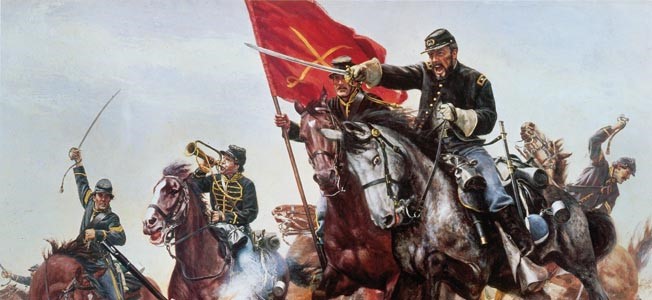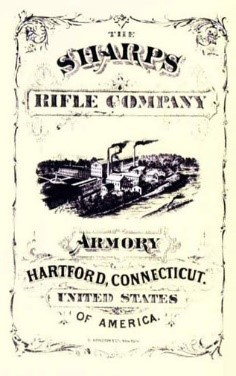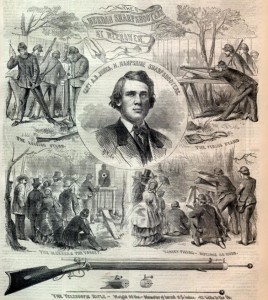The legendary Model 1873 Winchester rifle has been labeled the favorite fighting rifle of the West. But, the granddaddy of this Model 1873 and all models that followed was the iconic Model 1860 Henry Rifle and one of the most advanced firearm designs to come out of the American Civil War.

The Henry was known to help save the lives of many union soldiers and angered confederates who faced it. The Southerners described the Henry as “that damned Yankee rifle that is loaded on Sunday and fires all week long”. But, a Henry cost around $40 and about four times as much of the Springfield rifle and a typical union private only made $13 a month. So being a typical government shortsighted effort, the USA only bought 1,700 of them.
Taking up the slack, private organizations and state militia groups bought thousands more for the war effort. The invention of the Henry started with Benjamin Tyler Henry. While working for Winchester in the 1840’s, he patented a 15 round magazine breech loading repeating rifle that became known as the Henry rifle.
The next stepping stone in the Henry design was the Volcanic Repeater. This Volcanic Repeater Company changed its name in 1857 to the New Haven Arms Company and Oliver Winchester became its president and hired Benjamin Henry from the Springfield Armory. The result of Mr. Henry’s work and ingenuity was the Model 1860 Henry lever action rifle. This new rifle held 16 rounds of .44 ammo in a tubular magazine at the time when most soldiers were equipped with single shot muzzle loading rifles. It was a tough sale at first and one of the many marketing stories of this famous rifle was from a Union Cavalry Captain named Wilson.

The story goes when the Wilson family was having dinner in their Kentucky home seven confederate guerrillas arrived to kill Capt. Wilson. As he exited his home to face the killers, he grabbed his Henry and then opened fire killing all seven with eight shots. After verifying this incident, the State of Kentucky armed Wilson’s unit with Henry rifles. Others followed suit as Union Officers continued to give priority to this amazing gun and it helped win many battles and became just about as popular as the rugged Spencer Carbine. After the American Civil War era, the Henry continued to be used in the American West and even some Sioux Warriors used them against Custer at Little Big Horn.
This very popular and collectable lever action rifle is still made by the Henry Repeating Arms Company and is the largest lever-action rifle manufacturer in the United States. Their slogan “Made in America or Not at All” highlights the company’s dedication to maintaining the company’s domestic manufacturing heritage as well as the Henry Rifle’s history. If you can’t find an original Model 1860 Henry, the company will sell you a great looking replica that will look good hanging up in your den.
Find out more information by visiting with the Rockwall Gun Club located at 15950 State Hwy 205 in Terrell, Texas or by calling (972) 551-0470.
 The name “Sharpshooter” is usually tagged for someone who is an excellent marksman. But how did that title come about so many years ago? Thanks to Christian Sharps who patented his iconic rifle in the late 1840’s. His Model 1851 “box-lock” was developed in conjunction with Samuel Robbins and Richard Lawrence and produced thousands for the military.
The name “Sharpshooter” is usually tagged for someone who is an excellent marksman. But how did that title come about so many years ago? Thanks to Christian Sharps who patented his iconic rifle in the late 1840’s. His Model 1851 “box-lock” was developed in conjunction with Samuel Robbins and Richard Lawrence and produced thousands for the military. Before a new member was accepted into the Berdan unit, he had to prove his marksmanship skills and hit a target 10 inches in diameter at a distance of 200 yards consistently. The Berdan’s like other sharpshooters then and now singled out high value targets, but had the highest percentage of casualties of any unit in the war. After the Civil War, buffalo hunters like the famous “Buffalo Bill” Cody armed themselves primarily with the large caliber Sharps and sometimes were outfitted with scopes using a .50-.90 caliber bullet. This 11 pound rifle with its octagonal barrel absorbed much of the recoil and heated up very slowly.
Before a new member was accepted into the Berdan unit, he had to prove his marksmanship skills and hit a target 10 inches in diameter at a distance of 200 yards consistently. The Berdan’s like other sharpshooters then and now singled out high value targets, but had the highest percentage of casualties of any unit in the war. After the Civil War, buffalo hunters like the famous “Buffalo Bill” Cody armed themselves primarily with the large caliber Sharps and sometimes were outfitted with scopes using a .50-.90 caliber bullet. This 11 pound rifle with its octagonal barrel absorbed much of the recoil and heated up very slowly.
 . Since Dove Season is upon us and Bow Season is approaching fast; take a 16 second tour of about 40 acres of Archery and Clay Shoots.
. Since Dove Season is upon us and Bow Season is approaching fast; take a 16 second tour of about 40 acres of Archery and Clay Shoots.  . Call (972) 551-0470 to reserve a station today.
. Call (972) 551-0470 to reserve a station today.